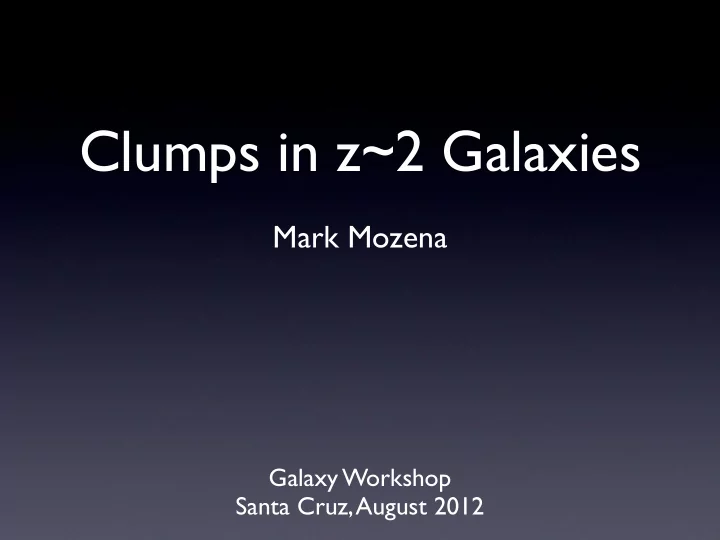

Clumps in z~2 Galaxies Mark Mozena Galaxy Workshop Santa Cruz, August 2012
Visual Morphologies Classifications are being done on all galaxies with H mag < 24.5 (dimmer galaxies were shown to have less reliable fits in GALFIT, G-M20 and CAS) in the CANDELS fields (starting with GOODS-S) - ~45,000 galaxies in CANDELS Classification is based primarily on H-band This sample is GOODS-S (ERS + Deep2 + Wide2) ~6000 galaxies visually classified in GOODS-S (~1200 with redshift = 1.5-2.5)
Quantifying Visual Morphologies Each galaxy was classified by 3-5 different people. Collapsed the classifications into various metrics from 0-1 for all the classifiers Spheroidicity - 0=disk 1=spheroid (received value of 0.5 if both were checked) Irregularity - 0=not irregular 1=irregular Asymmetry - 0=symmetric 1=asymmetric Clumpiness - 0=not clumpy/patchy (ie smooth) 1=maximum clumpiness/patchiness (3+ clumps/patches) Interaction - 0=no companion/interaction 0.25=non-interacting companion 0.5 interaction beyond segmentation map 0.75=interaction within the segmentation map 1=merger/train wreck Have structural morphologies (radius, sersic, axis ratio, etc from GALAPAGOS) and masses and rest colors from TFIT + SED fitting
Clump Fraction Simulations are from Nir measuring gas clump fraction of both in-situ and ex-situ clumps in the Hydro-Art Simulations with masses >1% or 0.1% of disk mass Simulations in general are less clumpy than observations - particularly at masses below 1e10. Better fits at masses > 2e10 Yicheng presented on Monday 10/15 UDF galaxies (log (Mstar) = 10-11) at z~2 are clumpy
Color-Mass At given color, clumpy galaxies are more massive with the clumpiest galaxies being the most massive. Clumpy galaxies are blue with no strong degree of clumpiness trend with color.
Color-Color Clumpy galaxies are in the blue/SF cloud (dusty and non-dusty regions). Clumpiest galaxies are not in the dustiest/reddest region.
Color-Color Clumpy galaxies are in the blue/SF cloud (dusty and non-dusty regions). Clumpiest galaxies are not in the dustiest/reddest region.
Size-Mass Clumpy galaxies are larger radii systems with clumpiest galaxies being at the largest radii. -clumps could pull sersic radii higher Do not see clumps in small radii systems - would see them to a SMA ~ 1kpc if they were there
Size - Axis Ratio Clumpy galaxies are larger radii systems but do not exhibit a strong axis ratio relation. -not preferentially found in face on disks or edge on chains
Additional Work Working with Chris Moody, Joel Primack, Priya Kollipara, Avishai Dekel, and Daniel Ceverino on latest hydro-art simulations will run these simulations through ‘CANDELization’ process and then through the same pipeline to compare them to actual galaxies No dust V i H With dust (SUNRISE) 3” z~2.33 log(stellar mass) = 11.04
Sausage Populations of Star Forming Galaxies at z~2
Star Forming Sample (blue and dusty) Spheroids are expected to have high axis ratios and the compact spheroids will have the small radii as well Disks (opaque) would have full range of axis ratio at given size Sausages (triaxial) expect axis ratio and size to depend on viewing angle - thin disks may look similar
Star Forming Sample (blue and dusty) Sample complete to Stellar Mass ~ 9.4 M_sun See a ridgeline relation between axis ratio and size
Star Forming Sample (blue and dusty) Ridgeline is present There is also a sample of galaxies in the general spread of axis ratio at a given size
Star Forming Sample (blue and dusty) Ridgeline is still present but less clear Possible transition is occurring to a more disk dominated population at higher masses
Star Forming Sample (blue and dusty) Higher mass galaxies have lost the ridgeline and looks much more like a disk population
Star Forming Sample (blue and dusty) Higher mass galaxies have lost the ridgeline and looks much more like a disk population
Star Forming Sample (blue and dusty) Low mass sample is incomplete but suggestion of a ridgeline is present in this low mass bin but there is a large axis ratio scatter
Star Forming Sample (blue and dusty) Conclusions As we divide starforming galaxies by mass - we see a possible transition from a population with large numbers of prolate (sausage) systems at low mass to a population more dominated by oblate (disk) galaxies at higher mass
Quiescent Sample
Sersic-Mass Clump-free systems have sersic >1 Clumpy galaxies are distributed from low to moderate sersic (n=4) at low and moderate masses
Quantifying Visual Morphologies
Recommend
More recommend